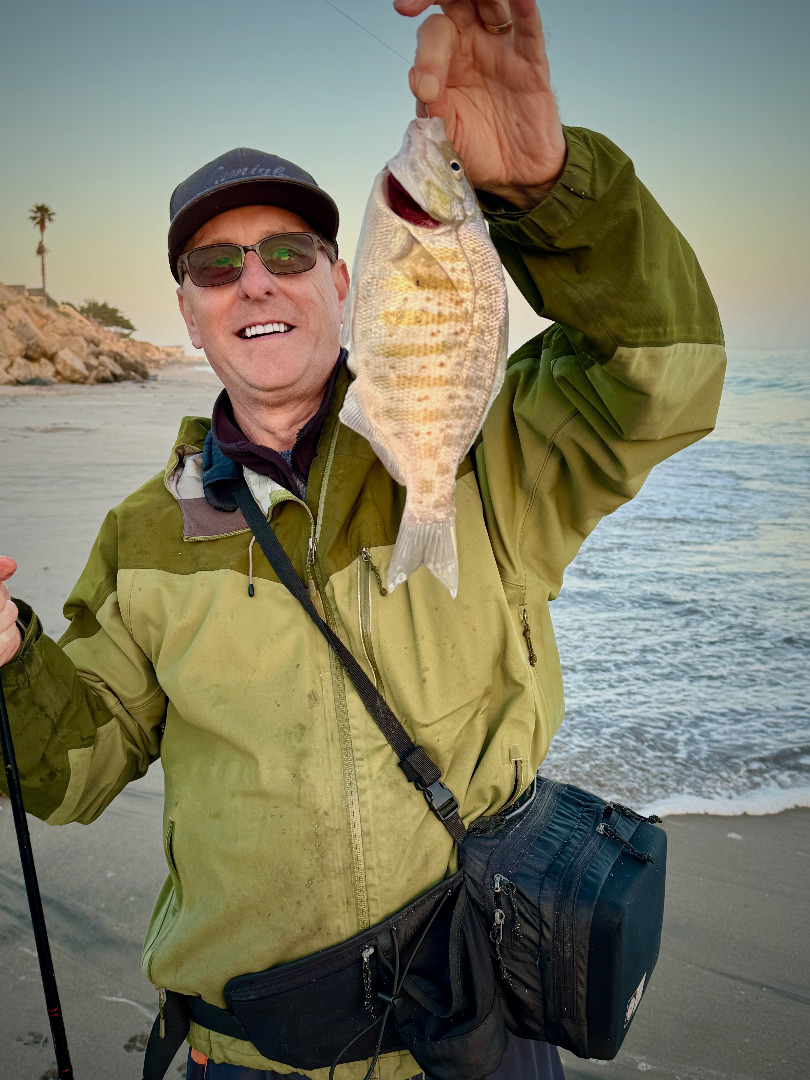Santa Cruz Fish Report for 7-19-2024
Where to fish while surfcasting
Santa Cruz - Santa Cruz, CA

by Allen Bushnell
7-19-2024
Website
Monterey Bay is only 25 miles across, from Santa Cruz to Monterey. But, we have 90 miles of shoreline as the bay arcs inland. Some of that shoreline, especially near Santa Cruz, is rocky with vertical cliffs looming above underwater reefs. Other areas are a mix of reefs and sand that change pattern as weather and sea currents scour or deposit sand atop the reef. Once we hit New Brighton Beach in Aptos, it’s pretty much sandy beaches all the way to the Monterey Harbor. Any and all of these areas can be good for fishing from the beach. Typically, surfcasters prefer to fish the sandy areas to avoid snags and seaweed.
In one sense, surfcasting is the simplest option for ocean fishing in our area. Go to the beach, kick off your sandals and cast out your line. Fish for an hour, or hang out all day. Some of the more serious striped bass anglers wait until dark, and walk the beaches with headlamps and high hopes. The bigger bass often bite at night. As an angler gains experience fishing the surfline, an awareness of deepening complexity grows. There are innumerable variables that can determine success while surfcasting, just like most other angling efforts.For this surfcasting series of columns we will speak mostly to those who are beginners or have yet to try their hand at surfcasting. We will keep it simple and describe the basics, setups and techniques. This week’s topic mostly looks at where to fish.
Surf perch are our most common prey. They are in our area and legal to fish all year round, and seldom grow more than 16 inches or around three pounds. Perch are a strong little fish though. Locating them, using the right bait and successfully landing is an accomplishment, even for the veteran surfcasters. The first concern is, where might the perch be today, or this week? Pay attention to reports online, make friends at the beach and share info and pay attention to the tides, waves and other weather conditions. Patterns for success will emerge.
On any beach, the waves roll in one after the other. That whitewater rushing in needs to flow back out to sea. This creates deep spots or rip currents where the water is deeper than the whitewater area. Sometimes it’s readily apparent where the rips are occurring. The water is dark, you can see it flowing out in a column towards open ocean and observe a muddy “mushroom” at the tip of the rip. Sometimes it’s a bit more subtle. These are deep areas are where the perch can usually be found. Rip currents are like little food conveyor belts bringing sandcrabs, worms and other edibles right to the fish.
Rips move water perpendicular to the beach, often at an angle, but generally moving the water away from dry sand. Other typical deep spots are the troughs. Especially when the waves are big, or for a few days after a big-wave event, a series of deeper sand trenches or troughs can be created by currents running parallel to the beach. Again, this is where you can find the perch because that moving water brings them food. One way to recognize a potentially productive trough is to look at the breaking wave way outside on a broad flat beach, like Manresa or Sand Dollar beach.
The outside wave breaks with explosive whitewater, then seems to “back off” a bit as it moves towards the beach. The backing off process sometimes looks as if the whitewater is climbing up the face of the wave while the wave itself becomes less vertical and more mushy looking. That’s another deep spot- a trough. Sometimes there can be two or three troughs between the outside sandbar and the beach, with hungry fish available in each one. If currents are running sideways, try casting towards a shallow” spot where whitewater if pushing in towards the beach, and let your bait get caught in the current, where it can sweep through the feeding zone. Next week we’ll look at rods, reels and rigs, and which works for what species.
< Previous Report Next Report >
< Previous Report Next Report >
More Reports

7-12-2024
Despite the muscular south swell that rolled through the bay this week, fishing remains very strong. Early morning conditions couldn’t...... Read More

7-5-2024
We’re in the full swing of summer now, and most representative species are on the bite. From Big Sur up...... Read More

Website Hosting and Design provided by TECK.net